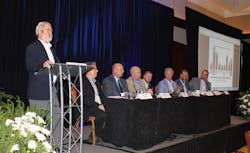Though OEMs and consumer packaged goods (CPG) manufacturers may not always agree on what constitutes fair pricing, it’s important for suppliers and users to communicate their requirements and understand each other’s concerns.
In a recent PP-OEM survey, conducted in conjunction with Packaging World (sister media properties of Automation World), OEMs and end users revealed their pain points associated with the machine buying process. A panel at the 5th annual Automation Conference & Expo brought OEMs and end users together, with representatives from OEMs Pro Mach, Massman, and ADCO along with end users Chobani, Amway and Abbott Nutrition, to discuss differing perspectives brought to light in the survey.
Following are some of the key topics where OEM’s and end user’s perspectives diverged:
What factors are most important to a successful factory acceptance test (FAT)? OEMs are much more likely than end users to place value on having the actual product—in sufficient quantities—for the FAT. The panelists pointed out that product used in the FAT may have come from a one-off mold, making it difficult to test. Pro Mach’s Barry Heiser added that “if the sample goes through [the machine] seven times, the product may change over the course of the FAT,” which can affect the accuracy of the test results. OEMs may shy away from negotiating to avoid losing a project over a stringent FAT requirement, but panelists agreed that there must be good communication and project management on both sides.
Mark Green, manager of global engineering at Abbott Nutrition, explained that a team approach is important, particularly when the user is still finalizing the package design and the OEM is building equipment. “There’s give and take. You have to communicate,” said Green. “Sometimes there are functional reasons why the prototype package was changed. If you’re an end user doing an FAT, be specific about the size of the FAT and details. Communicate about those things early on.”
What’s most important about the controls components you select? OEMs tend to look for best-of-breed controls components, while end users focus on maintenance, seeking components that are easily serviced or replaced.
Hugh Roddy, vice president of global engineering and project management at Chobani, voiced concerns about keeping a common platform. Though suppliers may want “the latest and greatest,” end users are concerned that those components have not been put through the ringer in manufacturing environments or that maintenance and process staff will not have the training to work with them. Roddy noted that while upgrades are a necessary part of manufacturing, “you have to be sure your company can support [them].”
OEMs may typically favor the newest technologies, but Jeff Bigger, president and CEO at Massman, is sensitive to end users’ needs. “Whenever we get a component supplier, the first thing I ask is ‘Have you talked to our customers?’”
What’s your approach to PackML? Based on the survey, OEMs are far more familiar with PackML than end users. More than 50 percent of responding end users said they were not familiar or have never heard of PackML. The standard can certainly ease integration headaches, but some end users fail to see the value in adding components with PackML if the rest of the line is not PackML-ready.
Bigger explained that many OEMs have jumped on board in implementing PackML, and said, “If we get asked for it, we want to be able to [provide] it.” Scott Reed, vice president of sales, marketing and customer service at ADCO, echoed that sentiment, noting that most customers do not feel it is critically important, but that ADCO offers it to remain competitive among customers who do request it.
Green was hopeful about the adoption of PackML among end users. “I believe that the longer it’s available, the more it will be accepted,” he said.
What constitutes a fair payment window? Amway’s John Giles said it was surprising that 53 percent of OEMs surveyed were willing to accept a payment window of 60 days or longer. Heiser offered a cheerful theory, responding, “If 50 is the new 40, then 60 days is the new 30.”

